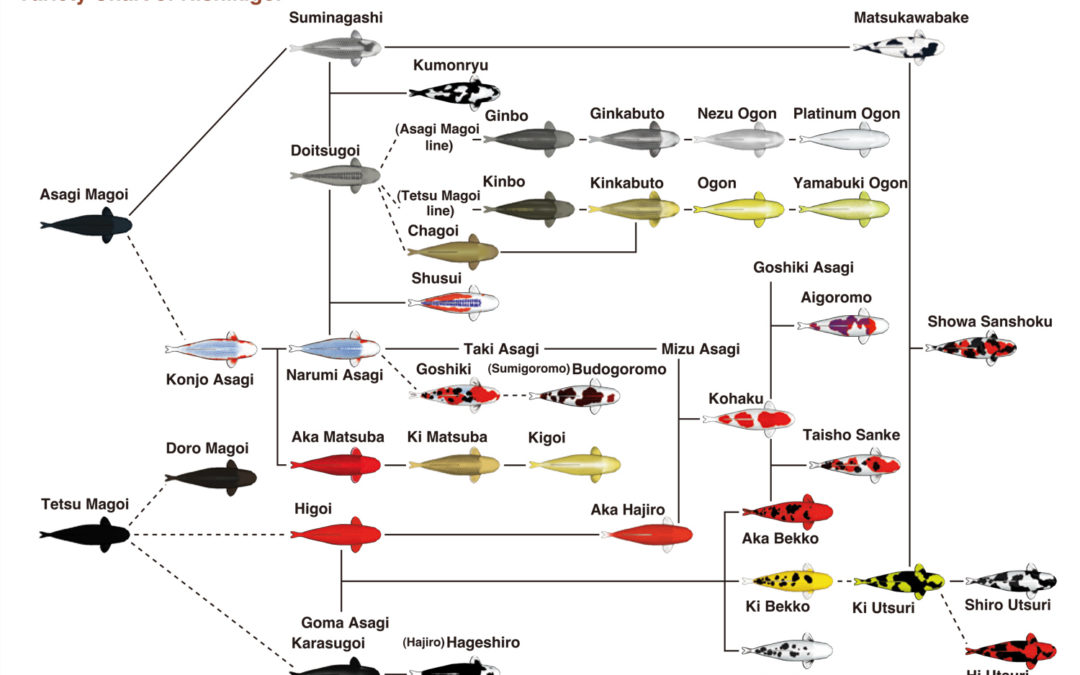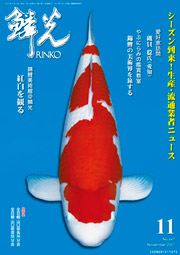Japanese Koi Varieties

Aigoromo 藍衣
Aigoromo is a white koi with red markings on which red-fringed indigo blue scales are seen. The orderly reticular pattern created by the blue scales is desired by many koi lovers ...

Asagi 浅黄
Asagi's entire back is covered with ai-iro (indigo blue), gunjo-iro (deep blue) and sora-iro (sky blue) scales. Each scale is fringed with white, which creates a reticular pattern. Its head is spotless and light blue-colored. Hi appears on the cheeks, the joints of pectoral fins, and the abdominals ...

Bekko
Koi with black markings on white skin are called Shiro Bekko. According to the colors of the skin, there are Aka Bekko and Ki Bekko ...

Beni Kikokuryu 紅輝黒竜
Kikokuryu with hi patches, produced from crossing a female Kikusui with a male Kikokuryu. Popular variety recently ...

Budogoromo 葡萄衣
Nishikigoi with koromo scaled pattern on hi plates. Its reddish brown color and the way how koromo patterns arranged look like a bunch of grapes. Budo means grape ...

Chagoi
This variety is close to the origin of Nishikigoi. Though its body color is brown, its hues vary from dark chocolate brown to light greenish brown ...

Ginrin Showa
Showa Sanshoku with silvery scales are called Ginrin Showa. Girin can come with every varieties ...

Goshiki 五色
Goshiki has fundamentally the same requirements for Hi patter as Kohaku. There are some types of Goshiki, such as the one whose entire body is covered with black reticular patterns and the one which has no black scales within the red markings. The latter gives a modern impression. There is also a variety whose skin is black ...

Hikariutsuri
Showa and Utsurimono with Hikarimono (metallic) body are called Hikariutsuri (Hikari Utsuri) ...

Hirenaga 鰭長
Hirenaga 鰭長 Hire鰭 means dorsal fins, naga長 means long. Hirenaga Nishikigoi refers to Nishikigoi with long fins. Hirenaga Nishikigoi was produced by Saitama Fisheries Research Institute. In 1977, the reigning Emperor (the Crown Prince at that time) visited there and advised to mate Hirenaga-koi in Indonesia with Japanese Nishikigoi to create the new elegant variety. They started to crossbreed and fixed it as one variety named “Hirenaga Nishikigoi” in 1982. You can keep them just by following the same ways as Nishikigoi. Pictures of Hirenaga bred by Kurihara Koi Farm in Saitama, Saitama is the birthplace of Hirenaga ...

Karashigoi からし鯉
Mustard single-colored Nishikigoi produced by mating Kigoi with Chagoi. Karashi means mustard ...

Kawarimono 変わりもの
A unique Nishikigoi. Nishikigoi that is difficult to be categorized into a specific variety at koi show regarded as Kawarimono ...

Kikokuryu 輝黒竜
Metallic Kumonryu, originally produced by mating Kumonryu with Doitsu Platinum Ogon ...

Kin Showa
Kin Showa was produced by crossing Showa Sanshoku and Ogon. Those with a golden body are called Kin Showa, and those with a platinum sheen are called Gin Showa ...

Kohaku 紅白
Kohaku is a white koi with red markings. This variety was the first one to be fixed. Because of the Japanese flag, red and white are the colors most commonly used in many celebrations in Japan. Thus, the Kohaku is the most popular variety of Nishikigoi ...

Kujyaku 孔雀
Kujyaku Ogon has a metallic body on which Kohaku-like Hi patterns and black Matsuba (pine needles) patterns, like a peacock's tail feathers, are laid. Kujyaku means peacock, Ogon means gold ...

Kumonryu 九紋竜
Kumonryu is a black Doitsugoi with white marking patterns. Its pattern changes according to the temparature and water quality ...

Matsukawabake 松川化け
The black and white Nishikigoi that have changing patterns over time. Fully scaled Kumonryu ...

Showa Sanshoku 昭和三色
Showa Sanshoku has red and white markings on black skin. Its dynamic marking pattern is very attractive. Like Taisho, Showa came from the name of the era (1926-1989) when it was produced and fixed. It is commonly called Showa ...

Shusui 秋翠
Since Shusui was produced by crossing Doitsugoi and Asagi, it has the colors of Asagi and an orderly row of large scales, peculiar to Doitsugoi. The clearer the color of blue is, and the more even the size of the scales are, the better ...
Find About History of Nishikigoi
To learn the most about koi, subscribe and become a paid member of RINKO Online!


